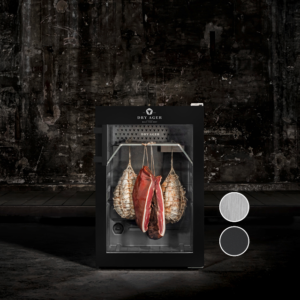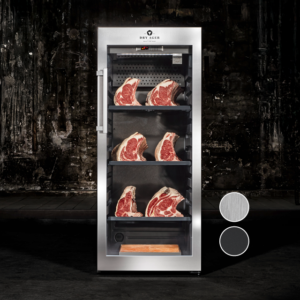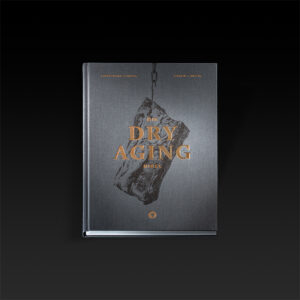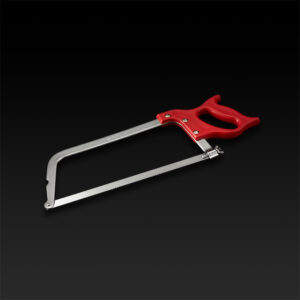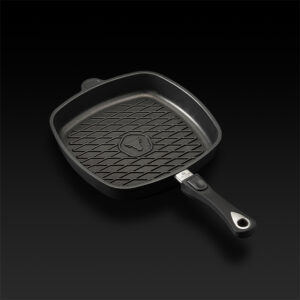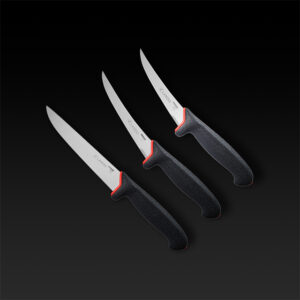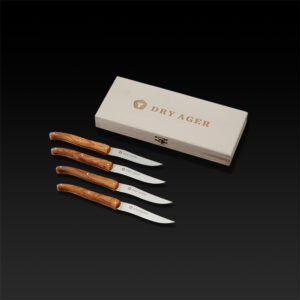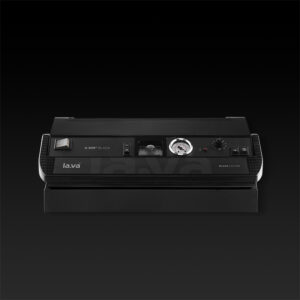DRY AGED BEEF TREND

Dry-Aged-Beef: a trend with long tradition
Dry-Aged Beef is currently being talked about by everyone. Not only chefs and gourmets rave about the unique taste of the dry matured meat, but amateur chefs and hobby grillers too. Even supermarket chains now offer barbecue goods labelled “Dry Aged”. Although this is seen as a new taste revolution, it is actually a traditional and well tried butcher craft.
Why meat needs to mature
After the slaughter the biochemical processes start in the meat. With the initial lack of oxygen in the meat the anaerobic glycolysis starts. It causes the so-called rigour mortis, it hardens the soft muscle tissue and has only a small water retention. Only after this phase the enzymatic maturation begins, which is so far advanced after about 8 days, that the meat fibres are soft again. The duration of the meat maturation is dependent on sex, age and breed of the animal.
The meat can mature 8 more weeks under good conditions to intensify the flavour. Incidentally, poultry and pork have to go through this process. However, these meats mature faster. 2-3 days is enough until the muscle meat is soft. Poultry and pigs can produce dangerous bacteria such as salmonella. Therefore, they may not mature for too long also due to hygienic reasons.
The roots of Dry-Aged beef
A look into history of art shows that the dry aging is not a modern invention. Already in the 17th century master painter Rembrandt kept on his painting a scene called “Slaughtered Ox”. A broken ox hangs in the dark butcher chamber, the red meat crossed by yellow fat. In the background, the curious look of the butcher’s wife. At that time the method was called simply “hang out”, because the meat was hung on the bone with a hook. The biggest problem was the erratic temperatures. Even beef can produce harmful bacterial during the maturation process. Only through the development of engineered cooling, this risk has been minimised.
Until the 1970s meat was ripened mainly dry. With the invention of the vacuum technology the food industry changed. The so-called wet maturation found its way. It ensures a faster maturation of the meat and has the advantage of less weight loss. Therefore more meat could be sold and thus obtained a higher profit margin.
Dry-Aging vs. Wet-Aging
A weight loss after 4 weeks of up to 30% in the standard dry ripening (DRY AGER maturity cabinet only about 7 – 8%) is economically disadvantageous, but the taste is the point. While the meat is aged on the bone, the unique spicy aroma is developed by the enzyme activities. Under a dry black outer layer that needs to be cut off after the maturation, the nutty-buttery flavour and crumbly structure forms itself. The decisive factor is the duration of maturation. The longer the meats hangs the more intense the flavour.
In the wet aging under vacuum, which is also referred to as wet-aging, there is less water retention. While the meat juices come out, but the flesh remains in contact with the liquid. This will continue to develop lactic acid bacteria, which provide a slightly sour-metallic taste. That’s not uncomfortable and for some meat it is even desirable.
When it comes to the delicacy of the meat fibres, both methods are equal. For those who seek the pure meat pleasure, dry aging is still trump. The Dry Aging procedure mainly serves good flavour.
Other Aging Methods
Aqua-Aging
Here the meat is aged about 4-5 weeks inserted in bottled water. This sounds simple, but is complicated in execution, because the whole process must run under strict hygienic conditions. The composition of the mineral also plays an important role. Through a high content of magnesium, calcium and hydrogen carbonate a strong taste variation is prevented. Sulphate and sodium should, however, be kept low because they turn the taste rather bitter.
Hautgoût
The French term can be literally translated as “high taste”. The term referred to the maturation of wild in fur or feathers. This creates a distinctive tart sweetish taste, which is caused by incipient putrefaction processes. This historic mature form, however, is no longer determined by today’s meat hygiene laws for sale.
Parchment-Aging
The parchment method is actually an advanced form of wet aging under vacuum. Here the meat is wrapped in parchment paper before vacuum sealing. That sucks out the meat juice, thus reducing the metallic-sour note.
Aging-Bags (Dry-Bags)
The easiest way to age meat that can also be carried out in a domestic refrigerator. Here the piece of meat is stored in a semi-permeable membrane bag (eg. a Lava A-Vac Dry-Aging bag) at 2-3 degrees. Emerging meat juices pass through the membrane envelope to the outside, while the meat is protected from external influences. The aging in the Dry-Bag is like the dry-aging process of aerobic maturation. Disadvantage here: No bones in the meat can be processed.
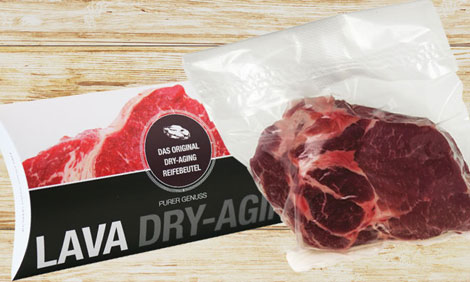
Mould Aging
In this aging method the meat is inoculated with special mould cultures, which are intended to influence the ripening process. The mould is not eaten. Mould matured meat should have an even more intense nut flavour. In Germany the mould maturation is prohibited by law.
Tallow Aging
A hundred year old technique in which the meat is coated in sections with exuberant beef fat. Thereby the meat is packed and can mature gradually and develop its delicate structure.
Dry Aging in DRY AGER
The DRY AGER meat maturing refrigerator ensures the dry aging in safe, hygienic conditions. It is also suitable for smaller food companies and even for the gourmet conscious household, thanks to its space-saving dimensions. Together with a food laboratory and butchers, a holistic technology has been developed that allows precise control of the maturing process.
The control element of the DX 1000 ensures a constant temperature, which is regulated in precise 0.1°C increments. This makes it suitable for dry aging of fresh meat and for degreening of well hung pieces of meat and sausages.
The humidity is controlled by the integrated DX HumiControl AirReg system and is electronically controlled from 60 to 90% in 0.1% increments. Even with large variations in ambient temperatures, the perfect microclimate remains in the unit.
Despite its compact appearance of the DRY AGER it offers enough space to allow even larger pieces of meat. The insulating glass door of the DRY AGER protects against UV rays and gives, at the same time, the possibility to check out how the meat is maturing. Dry-Aged Beef is not just a highlight in taste, it also looks good in stores and the catering sector.
Tips und Tricks for the perfect Dry-Age-Beef
If the conditions are as optimal as in the DRY AGER, a good steak has no more obstacles. For the best steak we will give you tips and tricks from the DRY AGER kitchen.
The right timing is everything
Not every piece of meat needs 8 weeks to develop its flavour. A tender filet, off the bone, can be ready in about 7 days. is done in about 7 days. On the other hand, the rib-eye can withstand an average of up to 28 days.
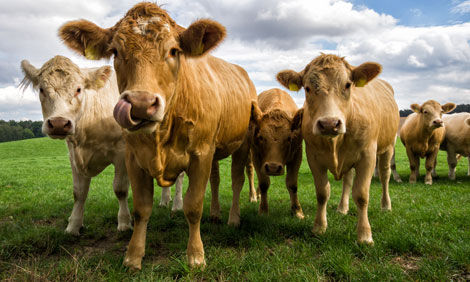
Happy cows give the best steaks
Anyone who wants to enjoy a good piece of meat, of course, has to start with the origin quality. An animal kept in good conditions and that have not been slaughtered under stress, also gives a more tender meat. The breed also influences the result. Angus and Wagyu cattle are favourites for steak lovers.
Bring spice to meat
The DRY AGER uses clever technology and also brings smart accessories with it. Thanks to the Saltair system with Crystal salt blocks, the meat is still spicy and unique in flavour after dry aging.
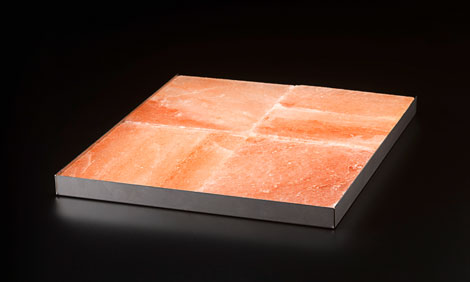
How to recognise good matured meat
Colour and finger pressure are the keywords. Well matured, tender steak meat is reddish brown and leaves a trough after pressure is applied.
